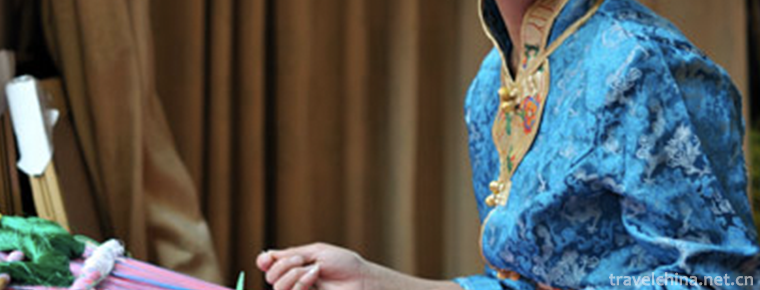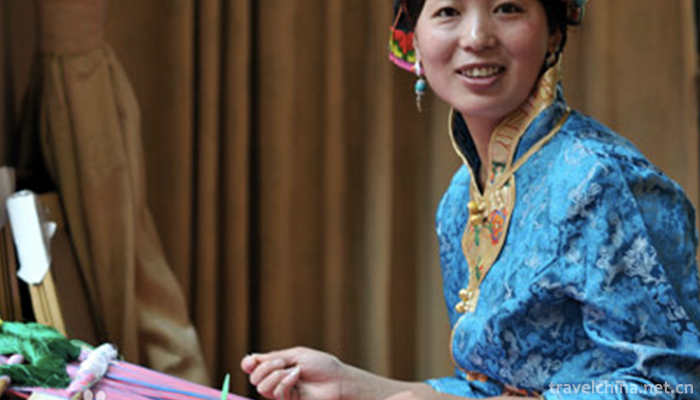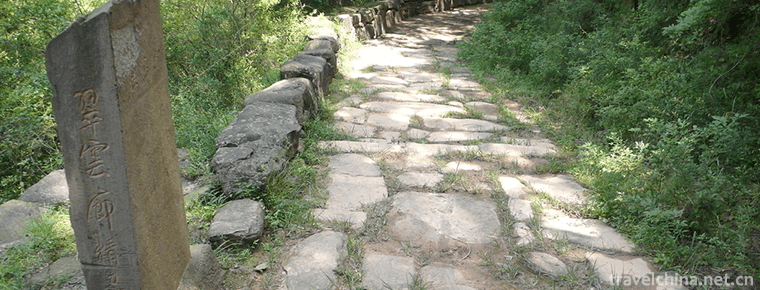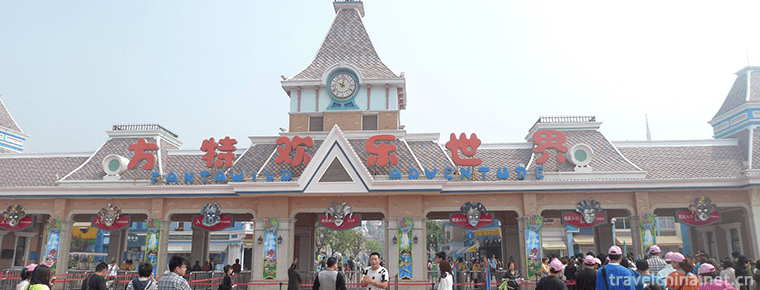2019-01-06

- By ChinaWiki.net
- Chinese Edition
- 2019-04-05
Tibetan knitting and embroidery
Tibetans are good at embroidery and textile, and exquisite craftsmanship adds infinite charm to their costumes, which is the most prominent manifestation of Tibetan costume regional style. Its embroidery, exquisite craft, needle method is not limited by longitude and weft, suitable for embroidery grass pattern; while Jiarong Tibetan knitting by a variety of straight lines and geometry of the pattern is simple and beautiful, with a sense of folding strength.
On May 23, 2011, Tibetan knitting and embroidery technology was approved by the State Council and listed in the third batch of national intangible cultural heritage list.
Historical origin
The inheritance of Jiarong Tibetan weaving and embroidery technology has a long history, especially the inheritance of textile technology can be traced back at least to the Neolithic Age. According to the excavation Bulletin of Hanye Site, Zhonglu, Danba County, the first period of cultural relics unearthed in this Neolithic site contains bony "spinning wheels". The first period of the site is between B. P5000 and B. P4500, determined by carbon fourteen. At the same time, a large number of bone needles have been excavated. This proves that as early as the Neolithic Age, the textile technology of Jiarong Tibetan area has developed. Before the Sui and Tang Dynasties, Jiarong Tibetan area was known as Jialiang, and its ancestors were called Jialiangyi. In the biography of the Northern History of Fuguo, it reads: "Chieftain of Jialiangyi Decree Family... Its common hat is leather, round as a bowl. Or with power. Clothes are full of fur. The term "wool shuttlecock" in this paper refers to the shuttlecock made of wool. In the Tang Dynasty, the Minjiang River and Dadu River basins to the west of Chengdu Plain were called "Xishan". In the "Old Tang Shu" and "New Tang Shu", the "Dongnu Country" was recorded under the "Xishan Zhuqiang". The most famous tribe among the Xishan Qiang people is called the Eight Kingdoms in the Xishan Mountains, and its elder brother and neighbours bear the brunt. In Tang Dynasty, the area around Xishan was the impact of the Tang and Tibetan regime exchanges. The Tang and Tibetan rulers wanted to own various ministries of Xishan, among which the elder brother and neighbor ministries gradually merged into the Tibetan people. "Old Tang Shu" once recorded the eight parts of Xishan that had been attached to the record, "the number of equal kings came to Korea, summoned to the Linde Hall... More than 20,000 people, such as Songzhou Shengqiang, were attached in succession. The adherent tribes Dong Mengqiong and Dong Bihe, the leader of Longnuo tribes, all gave Wei Qing the test and went to the Yuan Hui Next year to pay back the tin with gold and silk. At this time, the Han Dynasty embroidery was introduced into today's Tibetan and Qiang areas in Sichuan (referring to the Eight Kingdoms of Western Hills in Tang Dynasty). In the Yuan, Ming and Qing dynasties, the Tibetan region in Western Sichuan implemented the Tusi system. In addition to strengthening political domination in the region, the central authorities of all dynasties had frequent economic and cultural exchanges, which promoted the development of Jiarong Tibetan embroidery technology. In the middle of Qing Dynasty, after Qianlong's expedition to Da and Xiao Jinchuan, Han immigrants entered Jiarong area. These Han immigrants also brought the embroidery skills of Han nationality area. On the basis of the original embroidery, Jiarong Tibetans absorbed more embroidery skills of Han nationality, which made the embroidery skills of Jiarong Tibetan more mature and systematic, and have been inherited to this day. Yang Huazhen, the representative inheritor of Jiarong Tibetan embroidery technology, was trained by her grandmother and mother from an early age. She was good at picking flowers, double-sided embroidery and Pan-Gold embroidery. She was named by the State Council as the national representative catalogue inheritor of Jiarong Tibetan embroidery. She relied on cross-stitching "Heaven and Earth are auspicious", "Rui Beast Tu", "Hundred Birds Tu" and "Peony Flowers", tie-twist embroidery "Auspicious Eight Treasures" and needle insertion embroidery The God of wealth, Shakyamuni Buddha, Panjin embroidery, Four-arm Guanyin and flower-picking embroidery, Flower Cluster, were awarded the "Most Beautiful Chinese Handicraft Award in the Eyes of the World's Youth" by UNESCO. At the same time, she was awarded the National People's Congress Award for Best Cultural Heritage and the Special Honour Award for the World Youth Congress. Especially, they adopt the traditional Tibetan weaving and embroidery, such as pile, tie and button, and embroider two giant Tangkas, 22 meters high and 15 meters wide, Sakyamuni Talk and Thousand Hands and Thousand Eyes Guan Shiyin, which became the treasure of the town hall of Aba Museum at the Sixth National Minority Art Festival in Sichuan Province and Chengdu International Non-material Cultural Heritage Festival, and won the gold prize. In the art embroidery circle, she won the "Master of Chinese Arts and Crafts". Rong has become a Tibetan knitting and embroidering Gufeng snow thread, which is also known as the "ballet dancer on the needle tip".
Inheritance significance
Jiarong Tibetan knitting and embroidery directly reflects the aesthetic style and national characteristics of the nation, is the symbol of the nation, the carrier of culture, but also the perfect combination of practical and aesthetic, material and spiritual, art and technology.
Human arts and crafts
Jiarong Tibetans live in alpine valleys and jungle areas, where the climate is warm and the main mode of production is farming and animal husbandry. Historically, the main material of their clothing was felt (made of goat wool twisted into fine thread and hand-woven into clothing 30 cm wide and 3 cm long), and then tailored into garments, tied with colored yarn knitted waistbands, women also tied peach aprons, wearing hand-embroidered headscarves, footwear embroidered shoes. In the past, Jiarong women spent most of their leisure time rubbing wool and knitting clothes. A suit of clothes for the whole family almost consumed their whole life energy. Girls will begin to learn the skills of weaving waistbands, picking flowers, embroidery and other female workers from the age of 12. When they get married, they will be proud of who knits the waistbands with rich patterns, exquisite handicraft and large quantities. Besides, the waistbands are also gifts for love and gifts for their elders. Handicraft techniques such as embroidery and textiles play an important role in Jiarong Tibetan life, and they are highly dependent items in Jiarong Tibetan daily life.
The exquisite Tangka and Qiang embroidery works "Auspicious Eight Treasures", "Sakyamuni", "Four Arms Guanyin" were highly praised and won the "Best Chinese Handicraft in the Eyes of the World Youth" awarded by UNESCO. In view of Ms. Yang Huazhen's outstanding contributions in Tibetan and Qiang weaving, embroidery protection, inheritance and development, UNESCO also awarded her the "National People's Congress Award for Best Cultural Inheritance" and the "Special Honour Award for the World Youth Congress".
The inheritors of the fourth batch of non-legacy projects in Sichuan Province, Jiarong Tibetan knitting and embroidery with pick-up flowers, planned and created giant Tangka "Sakyamuni Talk" and "Golden Embroidery of Shibi Guanyin Pan", which were displayed at the 6th National Minority Art Festival of Sichuan Province and the traditional handicraft exhibition of ethnic minorities, respectively, and won the "Special Display Award" and the Golden Award.

Ask a Question
Your email address will not be published.



0 Questions